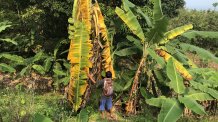Articles
Articles

A banana plant in Indonesia dying from TR4 (credit Clare Thatcher)
New tools needed to prevent plant disease pandemics
Plant disease surveillance, improved detection systems and predictive modelling – integrated at the global scale – are necessary to mitigate future plant disease outbreaks and protect the global food supply, researchers say.
The authors of a new commentary, published in Proceedings of the National Academy of Sciences, highlight the facts that plant diseases don’t stop at a nation’s borders and miles of oceans don’t prevent their spread.
The idea is to “detect these plant disease outbreak sources early and stop the spread before it becomes a pandemic,” said corresponding author Professor Jean Ristaino, of North Carolina State University.
Once an epidemic occurs it is difficult to control, Professor Ristaino said, likening the effort to the one undertaken to stop the spread of COVID-19.
While some diseases are already under some sort of global surveillance – Ristaino mentioned wheat rust and late blight, an important pathogen that affects potatoes – other crop diseases are not routinely monitored.
“There are a few existing surveillance networks, but they need to be connected and funded by intergovernmental agencies and expanded to global surveillance systems,” Professor Ristaino said.
“We can improve disease monitoring using electronic sensors that can help rapidly detect and then track emerging plant pathogens.”
Professor Ristaino said that efforts from a wide range of scholars – so-called convergence science – are needed to prevent plant disease pandemics.
That means economists, engineers, crop scientists, crop disease specialists, geneticists, geographers, data analysts, statisticians and others working together to protect crops, farmers and the people fed by those crops.
The GRIP4PSI Plant Science Initiative is helping to fund such a team at NC State.
Research is under way to model the risk of plant pathogen spread and help predict and then prevent outbreaks, the researchers report in the paper.
Modelling and forecasting disease spread can help mobilise mitigation strategies more precisely to stop pandemics.
Global plant disease outbreaks are increasing in frequency and threaten the global food supply, the researchers say.
Mean losses to major food crops such as wheat, rice and maize ranged from 21% to 30% due to plant pests and diseases, according to a paper published in 2019.
Or take the case of bananas, specifically the Cavendish variety, which has no resistance to the fungus causing Fusarium WiltTropical race 4 (TR4). This pathogen spread rapidly from Asia to Africa, the Middle East and recently into South America, where it affects Cavendish bananas – the main type of banana grown in the Americas for export.
Researchers at the University of Exeter, including co-author Professor Dan Bebber of the Global Systems Institute, are collaborating with scientists in Colombia to tackle the threat of TR4 through analyses of soil health and identification of microbes that could fight the disease in soil.
“Our research has shown that climate change, as well as human activities, is enabling the dispersal of plant pathogens around the world,” said Professor Bebber.
“We must help farmers prepare for future threats, as well as those they face now."
The emergence of new harmful plant pathogens adds other risks to the food supply, which is already strained by growing world populations.
“There is a need to link human global health and plant global health researchers to work together,” Professor Ristaino said.
“Food security and livelihoods are linked to agriculture and human health is linked to the food we consume.”
Date: 17 May 2021
